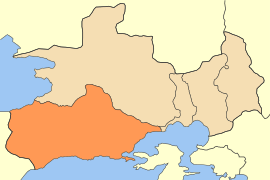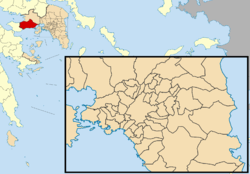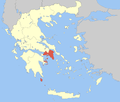Megara
| Megara Μέγαρα | |
|---|---|
 | |
 Megara | |
|
Location within the region  | |
| Coordinates: 38°00′N 23°20′E / 38.000°N 23.333°ECoordinates: 38°00′N 23°20′E / 38.000°N 23.333°E | |
| Country | Greece |
| Administrative region | Attica |
| Regional unit | West Attica |
| Government | |
| • Mayor | Grigorios Stamoulis |
| Area | |
| • Municipality | 330.1 km2 (127.5 sq mi) |
| • Municipal unit | 322.2 km2 (124.4 sq mi) |
| Elevation | 4 m (13 ft) |
| Population (2011)[1] | |
| • Municipality | 36,924 |
| • Municipality density | 110/km2 (290/sq mi) |
| • Municipal unit | 28,591 |
| • Municipal unit density | 89/km2 (230/sq mi) |
| Time zone | EET (UTC+2) |
| • Summer (DST) | EEST (UTC+3) |
| Postal code | 191 00 |
| Area code(s) | 22960 |
| Website | www.megara.gr |
Megara (/ˈmɛɡərə/; Greek: Μέγαρα, pronounced [ˈmeɣara]) is a historic town and a municipality in West Attica, Greece. It lies in the northern section of the Isthmus of Corinth opposite the island of Salamis, which belonged to Megara in archaic times, before being taken by Athens. Megara was one of the four districts of Attica, embodied in the four mythic sons of King Pandion II, of whom Nisos was the ruler of Megara. Megara was also a trade port, its people using their ships and wealth as a way to gain leverage on armies of neighboring poleis. Megara specialized in the exportation of wool and other animal products including livestock such as horses. It possessed two harbors, Pegae, to the west on the Corinthian Gulf and Nisaea, to the east on the Saronic Gulf of the Aegean Sea.
Early history
According to Pausanias, the Megarians said that their town owed its origin to Car, the son of Phoroneus, who built the citadel called 'Caria' and the temples of Demeter called Megara, from which the place derived its name.[2]
In historical times, Megara was an early dependency of Corinth, in which capacity colonists from Megara founded Megara Hyblaea, a small polis north of Syracuse in Sicily. Megara then fought a war of independence with Corinth, and afterwards founded Chalcedon in 685 BC, as well as Byzantium (c. 667 BC).
Megara is known to have early ties with Miletos, in the region of Caria in Asia Minor. According to some scholars, they had built up a “colonisation alliance”. In the seventh/sixth century BCE these two cities acted in accordance with each other.[3]
Both cities acted under the leadership and sanction of an Apollo oracle. Megara cooperated with that of Delphi. Miletos had her own oracle of Apollo Didymeus Milesios in Didyma. Also, there are many parallels in the political organisation of both cities.[4]
In the late 7th century BC Theagenes established himself as tyrant of Megara by slaughtering the cattle of the rich to win over the poor.[5] During the second Persian invasion of Greece (480-479 BC) Megara fought alongside the Spartans and Athenians at crucial battles such as Salamis and Plataea.
Megara's defection from the Spartan-dominated Peloponnesian League (c. 460 BC) became one of the causes of the First Peloponnesian War (460 BC - c. 445 BC). By the terms of the Thirty Years' Peace of 446-445 BC Megara was returned to the Peloponnesian League.
In the (second) Peloponnesian War (c. 431 BC-404 BC), Megara was an ally of Sparta. The Megarian decree is considered to be one of several contributing "causes" of the Peloponnesian War.[6] Athens issued the Megarian decree with the aim of choking out the Megarian economy. The decree banned Megarian merchants from territory controlled by Athens. The Athenians claimed that they were responding to the Megarians' desecration of the Hiera Orgas, a sacred precinct in the border region between the two states.
Arguably the most famous citizen of Megara in antiquity was Byzas, the legendary founder of Byzantium in the 7th century BC. The 6th-century BC poet Theognis also came from Megara. In the early 4th century BC, Euclid of Megara founded the Megarian school of philosophy which flourished for about a century, and which became famous for the use of logic and dialectic.
In 243 BC Megara expelled its Macedonian garrison and joined the Achaean League, but in 223 BC the Megarians left the Achaeans and joined the Boeotian League.
The Megarians were proverbial for their generosity in building and endowing temples. Saint Jerome reports "There is a common saying about the Megarians […:] 'They build as if they are to live forever; they live as if they are to die tomorrow.'"[7]
Geography
Megara is located in the westernmost part of Attica, near the Megara Gulf, a bay of the Saronic Gulf. The coastal plain around Megara is referred to as Megaris, which is also the name of the ancient city state centered on Megara. Megara is 8 km west of Nea Peramos, 18 km west of Eleusis, 19 km east of Agioi Theodoroi, 34 km west of Athens and 37 km east of Corinth. The Motorway 8 connects it with Athens and Corinth. The Megara railway station is served by Proastiakos suburban trains to Athens and Kiato. There is a small military airfield south of the town, ICAO code LGMG.[8]
The main town Megara had 23,456 inhabitants at the 2011 census. The largest other settlements in the municipal unit are Vlychada (pop. 1,462), Kineta (1,446), Pachi (542) and Lakka Kalogirou (517).
Municipality
The municipality Megara was formed at the 2011 local government reform by the merger of the following 2 former municipalities, that became municipal units (constituent communities in brackets):[9]
- Megara
- Nea Peramos
The municipality has an area of 330.11 km2, the municipal unit 322.21 km2.[10]
Towns and villages
- Agia Triada
- Aigeirouses
- Kineta
- Koumintri
- Lakka Kalogirou
- Megara
- Moni Agiou Ierotheou
- Moni Agiou Ioannou Prodromou
- Moni Panachrantou
- Pachi
- Sparta
- Stikas
- Vlychada
Historical population
| Year | Town | Municipal unit | Municipality |
|---|---|---|---|
| 1971 | 17,584 | - | - |
| 1981 | 20,814 | 21,245 | - |
| 1991 | 20,403 | 25,061 | - |
| 2001 | 23,032 | 28,195 | - |
| 2011 | 23,456 | 28,591 | 36,924 |
Notable people
- Orsippus (8th century BC), runner
- Byzas (7th century BC), founder of Byzantium
- Theognis (6th century BC), elegiac poet
- Eupalinos (6th century BC), engineer who built the Tunnel of Eupalinos on Samos
- Theagenes (c. 600 BC), Tyrant of Megara
- Euclid (c. 400 BC), founder of the Megarian school of philosophy
- Stilpo (c. 325 BC), philosopher of the Megarian school
- Teles (3rd century BC), cynic philosopher.
Facilities
- Mediumwave transmitter with a 180 metres tall radio mast, broadcasting on 666 kHz and 981 kHz
See also
Notes
- ↑ "Απογραφή Πληθυσμού - Κατοικιών 2011. ΜΟΝΙΜΟΣ Πληθυσμός" (in Greek). Hellenic Statistical Authority.
- ↑ Paus. i. 39. § 5, i. 40. § 6
- ↑ Alexander Herda (2015), Megara and Miletos: Colonising with Apollo. A Structural Comparison of Religious and Political Institutions in Two Archaic Greek Polis States
- ↑ Alexander Herda (2015), Megara and Miletos: Colonising with Apollo. A Structural Comparison of Religious and Political Institutions in Two Archaic Greek Polis States
- ↑ Aristotle, Politics V 4,5
- ↑ Sarah B. Pomeroy, Stanley M. Burstein, Walter Donlan and Jennifer Tolbert Roberts, Ancient Greece: A Political, Social, and Cultural History (Oxford: Oxford University Press, 1999).
- ↑ Jerome, To Ageruchia, Letter cxxiii.15
- ↑ World Aero Data
- ↑ Kallikratis law Greece Ministry of Interior (Greek)
- ↑ "Population & housing census 2001 (incl. area and average elevation)" (PDF) (in Greek). National Statistical Service of Greece.
External links
 Herbermann, Charles, ed. (1913). "Megara". Catholic Encyclopedia. New York: Robert Appleton Company.
Herbermann, Charles, ed. (1913). "Megara". Catholic Encyclopedia. New York: Robert Appleton Company.
